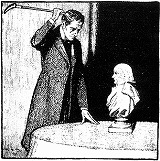“You will kindly sign that paper, Mr. Sandeford, in the presence of these witnesses. It is simply to say that you transfer every possible right that you ever had in the bust to me. I am a methodical man, you see, and you never know what turn events might take afterwards. Thank you, Mr. Sandeford; here is your money, and I wish you a very good evening.”
When our visitor had disappeared, Sherlock Holmes’s movements were such as to rivet our attention. He began by taking a clean white cloth from a drawer and laying it over the table. Then he placed his newly acquired bust in the centre of the cloth. Finally, he picked up his hunting-crop and struck Napoleon a sharp blow on the top of the head. The figure broke into fragments, and Holmes bent eagerly over the shattered remains. Next instant, with a loud shout of triumph he held up one splinter, in which a round, dark object was fixed like a plum in a pudding.

“Gentlemen,” he cried, “let me introduce you to the famous black pearl of the Borgias.”
Lestrade and I sat silent for a moment, and then, with a spontaneous impulse, we both broke out clapping, as at the well-wrought crisis of a play. A flush of colour sprang to Holmes’s pale cheeks, and he bowed to us like the master dramatist who receives the homage of his audience. It was at such moments that for an instant he ceased to be a reasoning machine, and betrayed his human love for admiration and applause. The same singularly proud and reserved nature which turned away with disdain from popular notoriety was capable of being moved to its depths by spontaneous wonder and praise from a friend.
“Yes, gentlemen,” said he, “it is the most famous pearl now existing in the world, and it has been my good fortune, by a connected chain of inductive reasoning, to trace it from the Prince of Colonna’s bedroom at the Dacre Hotel, where it was lost, to the interior of this, the last of the six busts of Napoleon which were manufactured by Gelder & Co., of Stepney. You will remember, Lestrade, the sensation caused by the disappearance of this valuable jewel, and the vain efforts of the London police to recover it. I was myself consulted upon the case, but I was unable to throw any light upon it. Suspicion fell upon the maid of the Princess, who was an Italian, and it was proved that she had a brother in London, but we failed to trace any connection between them. The maid’s name was Lucretia Venucci, and there is no doubt in my mind that this Pietro who was murdered two nights ago was the brother. I have been looking up the dates in the old files of the paper, and I find that the disappearance of the pearl was exactly two days before the arrest of Beppo, for some crime of violence - an event which took place in the factory of Gelder & Co., at the very moment when these busts were being made. Now you clearly see the sequence of events, though you see them, of course, in the inverse order to the way in which they presented themselves to me. Beppo had the pearl in his possession. He may have stolen it from Pietro, he may have been Pietro’s confederate, he may have been the go-between of Pietro and his sister. It is of no consequence to us which is the correct solution.